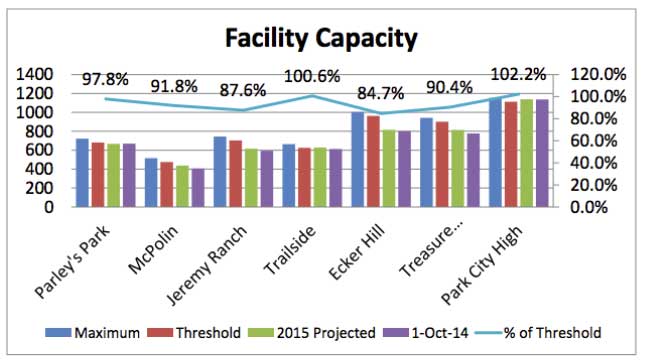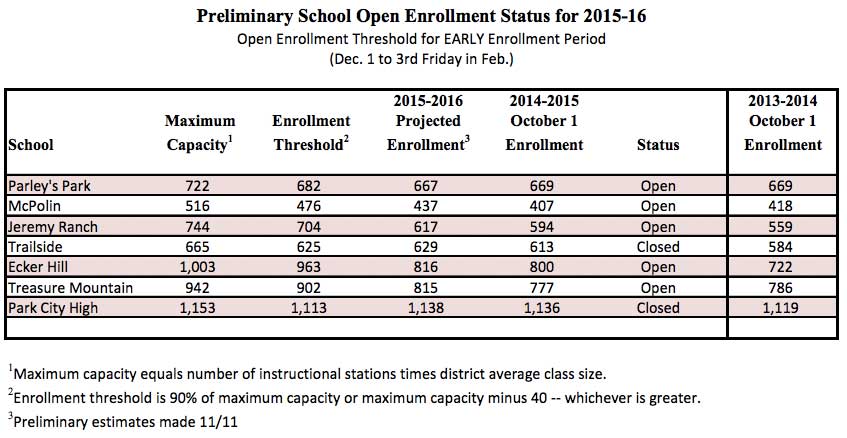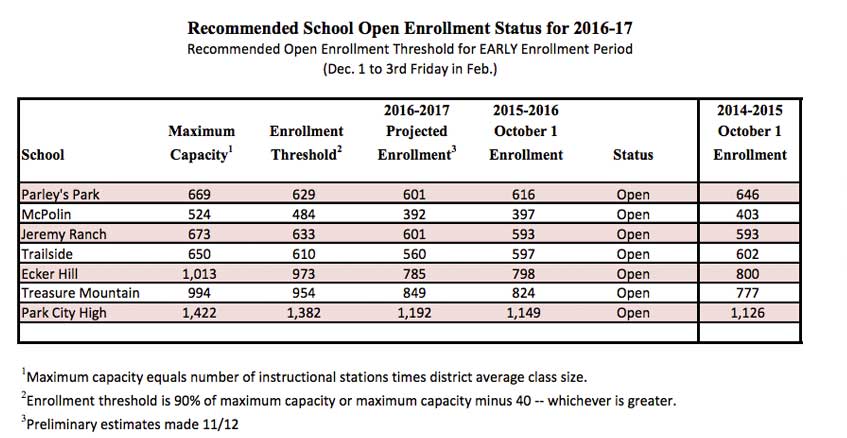School Board Still Needs to Work on Regaining the Community’s Trust
In the wake of the school bond defeat in early November, some of the school board members have done an admirable job meeting with the public to understand why people were against the bond. This is a very encouraging sign that hopefully the relationship between the board and the public won’t be adversarial going forward.
Yet, every once in a while something pops up and still makes me shake my head. If you recall, one of the chief school board arguments for needing the bond was because our schools were at capacity. Board members and district personnel often presented this chart to the public to demonstrate capacity:

I believe this chart was generally driven by open enrollment number calculated by the school district. Here are the Open Enrollment numbers for 2015-2016:
The high school and Trailside were closed, which means out of district students weren’t generally eligible to enroll at those schools. Keep in mind that the argument of “full schools” was being made up until election day. A few days after the election, the 2015-2016 open enrollment numbers were released:
You may now notice that the high school’s capacity has increased by 23%. You may notice that Parley’s Park’s maximum capacity increased by 8%. You’ll also see that capacity went down at some of the schools. The issue is that a few weeks ago we were being sold that our schools were full. Today we find that, at least per this estimate, that our schools aren’t going to be full.
I’m not arguing that there is some grand conspiracy to inflate and deflate numbers. After all, these numbers are driven by state of Utah formulas. According to School District representatives, changes to capacity at the high school are influenced by renovations that are occurring there. Capacity at our elementary schools are influenced the reading program being brought back into the classrooms (and out of dedicated rooms). So, there is a method to the madness.
Unfortunately, we as voters were told by the district that the schools were full. However, we weren’t told that other crucial piece of information before the election… that in about 10 days they wouldn’t be “full” anymore. School board member Julie Eihausen, during a recent school board meeting on the topic, said what I’m sure many people were thinking. She said, “I’m trying to wrap my head around how we went from 5 of 7 schools at capacity to having none.” The answer from the district Business Administrator, Todd Hauber, was that there were additional instructional spaces now and that the average class sizes had changed.
Yet, for me it’s still a matter of trust. Wasn’t the fact that our schools weren’t going to be full known before the election? If they weren’t going to be full and the district knew it, why wasn’t this told to the public? It’s like your child telling you their school day was good, but leaving out that crucial part about getting detention. Going forward, there’s a lack of trust that now will require extra vigilance.
It’s the same here. When the school district goes for their next bond (likely in 2016) and says anything about their enrollment numbers, how do we know we can trust it? While before we took them at their word, now someone will need to stand up and ask: “That high school capacity number what’s it based on? When was that calculation done? What’s changed since that number was created? Will anything else be changing that’s driving these numbers? Are these capacity numbers what a lay person would consider real capacity? When was your last projection for student numbers? How has that changed since then…etc…etc…etc…”
I suppose it’s not just these numbers that should be carefully vetted by the public. Any estimates done on timelines, construction costs, or needs likely should be carefully analyzed. For instance, I think most people believe that Treasure Mountain Junior High should be torn down. I didn’t start with that opinion, but I probably agree now. However, my agreement is largely based on the fact that there were 3 studies done that showed the costs required to maintain the building were in the $20 million range (almost as much as a new school). Yet, now I want to look at those studies. I want those to be passed by someone in our community with the knowledge to confirm that THE REQUIRED REPAIRS will cost almost as much as new school, so we might as well spend our money wisely. Perhaps the studies were all done in the right way. Perhaps, the costs estimates were only for the things that we HAD to have. Perhaps the studies’ findings were black and white and there could be no other argument other than to tear down the school.
But perhaps they weren’t.
That’s the problem with trust. Once it’s questioned, you start looking at everything (whether there is something there or not). As they say, fool me once — shame on you…fool me twice — shame on me.
It’s a great thing that the school board is working with the public to understand the pieces of the bond that the public doesn’t like. Yet, as the district gears up for the next bond, things need to be different the next time. Fair or not, the school district was already living in the shadow of cost overruns for the last renovations done to the high school. They were living in the shadow of running out of money in some of their funds, thus causing taxes to be raised. Now they are living under the shadow of how they used and presented capacity numbers.
At some point, that shadow’s going to be so dark, it’s going to be really hard to find their way out.



Comments
3 Comments
“The answer from the district Business Administrator, Todd Hauber, was that there were additional instructional spaces now and that the average class sizes had changed.”
It would be nice to know if this mostly means they are just increasing class sizes, or if there were extra rooms that can be used for instruction, or what. I don’t know that anyone would think increasing “capacity” by increasing class sizes is a great idea.
I agree that we need a full breakdown of WTF these numbers were based on, because it makes no sense to me either.
-Walt
Agreed Walter. I’m not even sure if these numbers are what should have been used or what should be used going forward when we are having discussions about how to rethink our schools.
It’s like they almost need to come up with their own formula based on all the complexities (desired class sizes, number of sessions, available space by time of day, etc.). I’m sure there are probably hundreds of inputs that would need to be looked at and some sort of computer model would need to be developed that accounted for say fluctuating kindergarten class sizes, half versus full day, desired size of class, available teachers and overlay that on each school, based on all the other calculations done of every other class and program … and how they all interact and impact each other.
Someone could probably spend months doing just that component. So, it’s not easy, but without the complexities and real-world dynamics accounted for an explained, I’m not sure how we get a real number of whether we are “FULL”… and I guess then what does full even mean.
Excellent piece. The trust issues run deep.
1. I spoke with Todd Hauber several times. I asked to see the assumptions behind the demographics and he told me that he did not have anything from the company that did the study. That is incredible! Either I misheard (I don’t think so), he doesn’t want me to see the assumptions and how the projections were put together, or this Board is totally incompetent to move forward on this basis with a $90 million (with interest ) project. Mr. Kaplan states on KPCW that “anyone who thinks Park City is not going to grow has their head in the sand”. Well, anyone who votes on an expansion without a deep understanding of the demographic projections is irresponsible. The latest enrollment numbers just drive that home.
2. The article brings up the classic question, “what did you know and when did you know it”. I am awaiting an answer. I probably won’t trust it.
3. In my communications with Ms. Conley on Full Day Kindergarten she told me about her excellent experience with it in Phoenix. She attached an academic article in support of her position. The article did not support her position at all. It said the opposite; that the effects of FDK are largely gone by third grade, that some children have bad emotional reactions, and that it should be a decision left to parents based on the maturity of their child and the conditions at home. Where is the trust? All Year Kindergarten has been shown to be far more effective for English Learning Students but no discussion of this option.
4. The we have the it’s one school, it’s two schools, it’s two schools in one debacle. The whole idea was that changing schools hurt academic performance, therefore one giant school at Ecker eliminated one school change. When we quoted from papers actually linked on the school website that showed this was a potential academic disaster one school morphed into two over night. Of course now we have added a new school change which undermines their original argument. Never mind that it is really cohort size that is the main problem as well as middle school in general. But we should trust them.
5. Academic performance morphed into dropout rate increases. Where are the numbers on drop out rates. Is it primarily an issue with Hispanic students? If it is, then that is more related to the demands of family to go to work to support the household. The whole one school two school issue is not even relevant to addressing this issue.
6. Then we have all of the undefined infrastructure which they claimed should not be held to the same standard as private construction. How big was the field house going to be? Was it just for students or also the community? We know the City was interested but we should just trust them with a blank check. The track was undefined. Would it have lockers, bleachers, lights, new road access across open space. Trust us they said. We don’t owe you the details. Same with the traffic issues. We have it under control, trust us.
So no, I don’t trust them at all and the latest comments do nothing but increase that feeling. It is more than just trust. It is an obtuseness, an arrogance, and an attitude of ‘how dare you question us when we have done so much work’. Let us see if anything changes in the coming weeks.
Leave a Comment